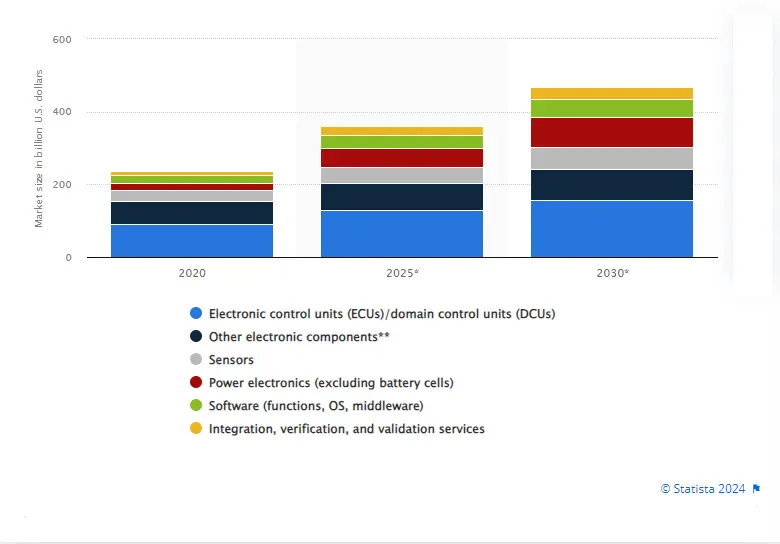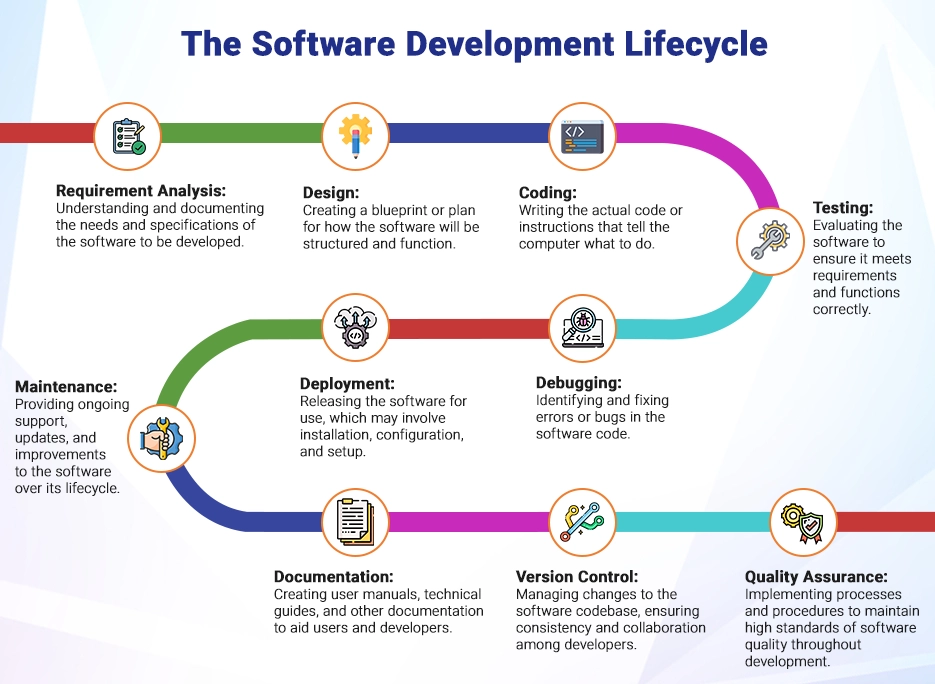This comprehensive article investigates the multi-layered universe of automotive software development, diving into key concepts, challenges, and technologies that are forming cutting-edge vehicles. Statista reports that till 2030, the global market size of automotive software was estimated to be around $26 billion. The automotive software market is expected to continue growing as vehicles become increasingly connected, autonomous, and electrified.
As the world moves towards shrewd technologies and digital integration, an honest legend ascends in the automotive industry. In this situation, I’m not alluding to strong engines or streamlined plans — we’re discussing automotive software and development groups. Ok indeed, you heard me right, automotive development! It might appear to be subtly contrasted with your customary automobile lord. However, it is rapidly turning into the actual heart of every vehicle we look at.

As we dive into the profundities of automotive software systems and their part in changing contemporary automobiles into mechanical wonders. Let us light our excursion with an itemized prologue to this exceptional field.
What is Automotive Software Development?
Software development in the automotive industry isn’t simply a pattern — it’s a transformation. View it as being put in the driver’s seat of an engine vehicle, a mind-blowing transformative shift that is exploring our direction through vehicular innovation.
Importance of Automotive Software Development
Very much like mastering coding is urgent for creating software and making effective projects. Embracing digital transformation in automotive software engineering is basic for enhancing vehicle plans and usefulness. This progressive viewpoint gives manufacturers a competitive edge while offering consumers unprecedented convenience and connectivity through automotive software development services. From controlling infotainment systems to upgrading safety highlights commitment. Automotive software solutions are directing our vehicles towards becoming more secure, more astute and seamless machines.
Automotive Software Development Advantages
Here are the absolute most attention-worthy positives:
1. Comprehensive Controls
Ever longed to have unlimited authority over your vehicle with simply a swipe or voice order? On account of advanced automotive invoice software, presently you can!
2. Increased Safety Measures
Advanced collision detection, adaptive cruise control, blind-spot monitoring – these aren’t components of a science fiction film any longer. They’re all-year Christmas presents gifted by modern vehicle systems fueled by brilliant software developments.
3. Performance Optimization
Envision awakening every day energetic as well as eager to drive! Integrative vehicle improvements, for example, automotive CRM software with eco-friendliness examination or custom driving modes can offer that rich driving experience we as a whole need.
Scope and Applications of Automotive Software Development
Your typical vehicle presently has around 100 million lines of code, almost multiple times over an Android working framework. Given the ascent in automotive software development company applications, this number is set to soar further. Vehicles have now developed past transportation machines — they are strong PCs going on four wheels! By 2030, the global automotive software and electronics market is expected to reach $462 billion, representing a 5.5 per cent CAGR from 2019 to 2030. In contrast, the overall automotive market for passenger cars. Light commercial vehicles (LCVs) are projected to grow at a compound annual rate of 1 per cent in the same period.
From 89 million units in 2019 to just 102 million units in 2030. The scope of automotive software engineering includes regions like Advanced Driver Assistance Systems (ADAS), infotainment, telematics, and powertrain control systems. As time passes, I dig further into my work in automotive software engineering. It turns out to be progressively clear how characteristic these systems are for upgrading vehicles’ performance and capacities.
Key Concepts in Automotive Software Development
Automotive software development, combined with a dominance of coding abilities. It is an indispensable cog inside the metaphorical wheel of the modern automobile industry. This segment means to demystify a portion of the centre concepts connected with creating automotive software.
Overview of Automotive Software Systems
The vehicle software and development process assumes an imperative part in interpreting mechanical usefulness into digital control. Focal around this progressive shift are various kinds of automotive software systems each addressing unmistakable perspectives like engine control, infotainment, safety elements and significantly more.
These systems incorporate yet are not restricted to:
- Engine Control Units (ECU) for optimizing eco-friendliness while cutting down emissions.
- Infotainment Systems guarantee pleasant and entertaining vehicle interiors.
- Advanced Driver Assistance Systems (ADAS) advance more secure streets by diminishing human blunders.
- Such advanced software systems have changed traditional vehicles into innovative machines on wheels upgrading drivers’ encounters through unprecedented conveniences and safety measures.
Vehicle Architecture and Software Integration
A significant component supporting fruitful review through the vehicle software development focal point is the comprehension of automotive diagnostic software architecture alongside its exchange with coordinated software.
The most recent automobiles look similar to moving PCs organized by unpredictable layers of specific software modules working as one. Furthermore, design choices likewise influence huge elements including future upgradeability, integration prospects, cost-effectiveness, and even secondary selling administration contemplations recommending how well-established these decisions are.
For example, carrying out a bound-together vehicle architecture instead of isolated modules permits simpler cross-usefulness prompting more noteworthy synchronization among highlights further empowering smoother activity for drivers.
Components and Modules in Automotive Software
Automotive software engineering operates utilizing explicit components, for example, ECU or sensors among many more primary components. They interweave seamlessly framing a sweeping organization inside each automobile.
Every part plays its extraordinary part; blinkers’ flight data is transferred from front-facing sensors permitting ADAS systems to apply brakes when considered significant in this way saving lives possibly in danger. The importance of such components can never be overemphasized, making them an indispensable piece of automotive software in general.

Embedded Systems in Automotive Software Development
With huge steps made by the automobile ruler that is automotive software development. Embedded systems have developed to stand firm on a footing much the same as spines inside this digital upset.
An embedded framework alludes to a PC framework explicitly intended to perform one or a few committed works frequently incorporated inside other complete equipment parts. From overseeing engine control units (ECU), cooling systems, and power-directing helping gadgets, automotive repair management software structure a ubiquitous perspective taking care of vehicle functionalities.
These conservative yet strong microcontrollers support awesome capacities accomplished by modern vehicle systems. Like self-leaving, and environment control schedules which appear to be practically mysterious till as of late. Without a doubt, their quiet efficiency likewise contributes greatly to the acknowledgement of a more vainglorious dream – self-driving vehicles. Their job might appear to be unassuming however their commitment is progressive.
Automotive Software Development Challenges
Automotive software development projects aren’t without their reasonable portion of challenges. Given the basic idea of venture management in this field, it is critical to acknowledge these obstacles as they fundamentally affect project results.
1. Complexity Management
The primary roof we hit inside automotive software development is overseeing complexity. As vehicle software development progresses, systems are advancing into modern builds involving various components going from basic sensors to complex embedded controllers.
Vehicle software can comprise up to 100 million lines of code, over two times that of a typical space transport’s flight framework. With such complexity comes the potential for bugs and blunders. Which might prompt utilitarian issues or ineffective security measures by Custom Software Development for Startups. Mastering coding methods explicitly for the automobile industry turns into a command instead of a choice.
2. Addressing this Issue Requires a Dual Approach
Focusing on proficient plan architecture: Developers should lay out a sound basis before moving towards execution. Executing seclusion: Separating enormous systems into more modest reasonable segments permits simpler upkeep and improved bug following. A harmony among arranging and execution while overseeing complexity prompts better expectations in automotive software engineering.
3. Safety and Security in Automotive Software
As vehicles become more drenched with innovation, the safety and security of automotive software have become the overwhelming focus. Gartner highlights the importance of cybersecurity in automotive software development. They predict that by 2023, 60% of all connected vehicle attacks will exploit vulnerabilities in the underlying software rather than directly targeting the vehicle’s hardware. Unapproved admittance to inside systems could lead not exclusively to information misfortune. Additionally to actual harm given the mechanical control employed by vehicle software.
Robust security protocols should be coordinated across all components included, limiting weaknesses that might be taken advantage of by pernicious dangers. This incorporates utilizing encryption techniques for information transmission and capacity alongside customary updates guaranteeing negligible adventure windows.
Explicit approaches like Cybersecurity Failure Mode and Effect Analysis (CFMEA) can empower proactive danger distinguishing proof during developmental stages empowering secure plan standards right from initiation.
With additional associated automotive inventory management software on the streets every day, controllers also are moving forward with requests for built-up network safety protocols comprehensively safeguarding end clients.
4. Industry Standards and Regulations
Automotive software development likewise needs to battle with an intricate snare of industry standards and regulations. These structures are ceaselessly developing, reflecting changes in innovation, market needs, and cultural assumptions.
An illustration of such an administrative body is ISO 26262 named “Street Vehicles – Useful Safety”. This standard accentuates utilitarian safety in automotive systems guaranteeing negligible likelihood of framework failures prompting mishaps.
Understanding and integrating these necessities into the item plan from the beginning phases can alleviate the gamble of rebelliousness. Which might bring about exorbitant changes down the line, or even reviews whenever hailed after creation.
Administrative adherence additionally offers long haul advantages by ingraining better quality confirmation rehearses subsequently improving in general performance profiles of software-empowered automobile components. As rigid as Software Development Companies in Texas could show up for software developers themselves, these benchmarks to a great extent impact customer trust provoking more extensive acknowledgment of tech-forward portability solutions.
Gear up for the Future – Transform your Automotive Vision into Reality
Innovations in Automotive Software Development
Advancements are dependably at the core of progress, and it’s the same for the Automotive software development process. As engineering keeps on extending past limits, the combination of refined technologies has without a doubt rejuvenated surprising innovations.
1. Connected Car Technologies and the Internet of Things (IoT)
The advancement of automotive software engineering has acquainted us with another time when vehicles accomplish something beyond transport. With connected car technology, every vehicle turns out to be part of a tremendous organization, achieving a wide unique change in the auto world.
What gets this evolution underway is, as a matter of fact, IoT. The consideration of IoT gives your automobile internet availability, permitting it to speak with outside devices. Be it exploring traffic lights or predicting mechanical issues; everything happens seamlessly through ‘vehicle-to-everything’ (V2X) communication.
For example, envision on the off chance that your ‘smart’ refrigerator could convey a message reminding you to get milk coming back from work. Likewise, by constant information transmission across various components inside and outside the vehicle going from motor details to weather circumstances. The customized driving experience gets upgraded essentially for many Offshore Software Development Companies. In this manner dominating coding for such advanced applications can be very rewarding and straightforwardly contributes towards elevating automobile industry proficiency.
2. Artificial Intelligence and Machine Learning
Gartner predicts that by 2025, over 50% of the software in cars will be open-source components, contributing to increased innovation and collaboration within the automotive industry. How have automobiles changed from being simple machines into canny devices that learn our ways of behaving? Indeed, artificial intelligence (AI) and machine learning hold these responses.
Outfitted with AI-powered algorithms, vehicles can now break down sensor information quickly, empowering basic capabilities like prescient maintenance and, surprisingly, autonomous driving over time. All the more basically: cars can learn while they journey! Machine learning further expands this portrait. These set-ups use gathered information over time refining processes prompting overall framework improvement and determinedly suppressing software hiccups or failures because of unexpected scenarios.
3. Autonomous Driving Systems and Self-driving Cars
It’s astonishing yet obvious – the thought of self-driving cars is not a modern idea any longer but a reality!
Autonomous driving systems are quickly saturating the texture of automotive custom enterprise software development. These software-intensive systems are primarily guided by advanced sensor technology, robotics, complex algorithms and high-powered processors facilitating environmental awareness and navigation ease.
These king software marvels guarantee security while copying human-like driving capacities. Accordingly, this software development in the automotive business is revolutionizing our everyday drive as well as addressing an evolution in mobility itself. However, it’s vital to recall for Transportation Management Software Development that thorough trust-wide acknowledgement of this technology addresses a test requiring overwhelming approval through recreation conditions before allowing them to raise a ruckus around town.
This astonishing period of development exhibits how advancements steadily change scenes imparting critical movement inside the automotive software development arena. In impending articles, we’ll dig further into investigating more trends molding the automotive sector in the future amid such profoundly entwined mechanical advances.
Future Trends in Automotive Software Development
While automotive software development is a powerful field, certain key trends stick out. This incites us to reclassify how we might interpret what an automobile can do and how drivers collaborate with them.
1. Electric Vehicles and Sustainable Mobility Solutions
Electric vehicles (EVs) are not only the future — it’s clear they are a big part of our present. However, the job that the automotive software industry plays in EVs often gets overlooked amid conversations about battery power and charging foundations. In reality, software development in the automotive custom software development company in USA is central to unlocking the maximum capacity of electric automobiles.
Every part of the electrical driving experience depends vigorously on PC systems for activity. From overseeing battery utilization to streamlining execution and controls, advanced software solutions make electric driving conceivable. A valid example is Tesla — the undisputed ‘automobile king’ has revolutionized this portion by coordinating smart highlights like over-the-air updates making them similar to moving PCs. The subsequent opportunities for nonstop enhancements present vast open doors. Yet in addition huge challenges for software engineers who should guarantee immaculate working given these vehicles’ green nature.
Endeavoring towards sustainable mobility solutions, developers are imaginatively assembling stages equipped for coordinating mobile devices seamlessly with both ordinary power matrices and current efficient power energy sources. Most would agree that we’re yet scratching barely at the surface.
2. Voice Recognition and Natural Language Processing in Car Interfaces
As mobile technologies keep evolving, so too does our assumption for comfort with auto users these days seeking sans-hands tasks as a standard rather than a special case. Enter voice recognition close by natural language processing (NLP), changing how we cooperate with car interfaces drastically.
Simply envision directing your vehicle through spoken guidelines! Undertakings, for example, navigation input, media control or even more multifaceted functionalities including remote start. They are presently not living in fantasy land; on account of Enterprise App Development Companies engineering ability to improve daily travel experiences immensely.
The move towards natural language recognition implies our cars comprehend directions as well as decipher settings, diverting them from simple vehicle devices into keen colleagues. While very normal in the extravagance portion, even more, reasonable models.
3. Augmented Reality and Heads-up Display in Automobiles
To further streamline driver collaboration while improving security, automotive software is consolidating augmented reality (AR) and heads-up displays (HUD). This cutting-edge technology projects for Transportation Management System key data straightforwardly onto windshields or exceptional screens at eye level, lessening interruptions fundamentally.
Whether it’s displaying navigation signs, speed limits, or incoming call details, AR HUD technology keeps your eyes out and about without missing crucial alarms. The adoption of advanced driver-assistance systems (ADAS) and autonomous driving technologies is driving the demand for sophisticated automotive software solutions. Forbes suggests that these technologies will revolutionize the automotive industry, leading to safer and more efficient transportation systems. Past the aloof display, this development can effectively direct during complex moves utilizing overlaid arrows marking paths to take while exploring occupied crossing points. A super current co-driver if there ever was one!
Pioneers, for example, BMW are utilizing these technologies inside their most recent models. Displaying how cutting-edge automotive software development remains closely connected with a superb user experience. This combination of ‘genuine’ and virtual universes can certainly appear to be overwhelming at first.
Reflecting upon the latest things forming automobile stages today pinpoints obvious headway made through inventive automotive software solutions touching every part of vehicle activity. While invigorating, none will deny challenges awaiting us — yet by embracing advancements by custom software development companies in USA like electric drive together with evolving human-car interfaces while guaranteeing progress with consistent security/well-being. These obstacles will be overcome in transit to an upgraded mobility future.
Successful Examples of Automotive Software Development Projects
Our excursion in the domain of automotive software development wouldn’t be finished without looking at a couple of true examples. These monsters have embraced automotive software engineering with gusto. They have reclassified boundaries and set new productivity and quality standards for automotive organizations.
1. Tesla
Known as “The Automobile King” in electric vehicle (EV) technology, Tesla has reliably separated itself through spearheading software solutions. Dominating coding to achieve an advantageous mix of effectiveness and extravagance. Tesla’s onboard working framework firmly incorporates hardware and software parts.
One great representation is its Autopilot highlight which involves broad sensor information for semi-autonomous driving. The Over-The-Air (OTA) updates guarantee bug fixes as well as empower steady improvement of car highlights post-buy – setting new assumptions for car possession experience.
Tesla’s commitment to automotive software development isn’t exclusively about making splendid cars. Their constant quest for sustainable energy usage underlines their importance. This obligation to inexhaustible sources will keep molding their narrative and pushing ahead.
2. BMW
Standing tall on the pillars of extravagance and execution, BMW has been successfully enlarging user experience with advancements in connected car technologies. From dominating coding ideas to becoming forerunners in software development inside the best custom software development companies — BMW’s story is amazing.
Have you heard about the BMW Astute Individual Aide? That is a high-grade incorporation between artificial intelligence and automotive software. It answers voice orders like a loyal companion by changing lodge temperature or arranging ideal courses considering traffic conditions.
Best-in-class display tech merges visual allure and useful simplicity into one captivating bundle. The iDrive framework gives a touch-screen infotainment interface that naturally organizes vehicle navigation, entertainment systems, and communication applications generally inside strikingly simple reach.
3. Google Waymo
Presently we should investigate a groundbreaking phenomenon that sits at the crossing point of automotive software development, self-driving technology and thorough machine learning – Google’s Waymo. This famous venture has been pushing the boundaries of both autonomous vehicles and driving systems.
Waymo utilizes a multidisciplinary way to address diverse challenges like consistency. With industry standards, ceaseless joining, and complex administration in automotive and vehicle software development costs projects — an exhilarating excursion through vehicle-software coordination.
With profound learning algorithms upheld by Google’s comprehensive road planning information base. Waymo is creating front-line ‘driverless taxi’ solutions. At some point, this technology aims to challenge as well as take out human mistakes from metropolitan mobility conditions!
The mediating years have seen numerous disruptors, yet these three forces to be reckoned with. Tesla’s electric dream, BMW’s connected user experience, and Waymo’s vision for completely automated transport. Yield convincing stories on how inventive automotive software engineering can reshape our movement longs for tomorrow.
We navigated a long excursion together investigating the immense domain of automotive software development. From carving out a clear comprehension of what is this discipline to valuing its importance and advantages, both for makers and users, we have progressed significantly.
As software technology keeps on progressing quickly, we likewise got a brief look into tools, dexterous strategies and technologies facilitating automotive software engineering. These incorporate different programming languages or systems specifically intended for this reason to reenactment strategies and testing procedures. All sticking to dexterous approaches guarantees more noteworthy productivity.
Further highlighting the creative steps being made in the field were experiences gotten from connected car technologies and IoT-based automotive applications too by custom software development outsourcing. The utilization of leading-edge AI and machine learning algorithms is opening up new outskirts. Considering jumps towards autonomous driving systems and self-driving cars.
Transform Your Software Vision into Reality – Book A 30 Minutes Free Consultation!
Conclusion
In the domain of automotive software development, a powerful scene of challenges and advancements unfurls. Molding the future of connected and autonomous vehicles. Autonomous driving refers to moving a vehicle or a transportation system without a human driver’s assistance. The J3016 standard, which SAE International (Society of Automotive Engineers) released in 2014, outlines the various development stages leading up to fully autonomous vehicles. Independent driving autonomy levels vary from 0 (no automation) to 5 (complete vehicle autonomy). As the business explores complexities, from security worries to the interest in cutting-edge highlights. Developers consistently push boundaries to meet evolving assumptions. Striking harmony among development and dependability is paramount in conveying strong, secure, and user-accommodating automotive software. The excursion ahead guarantees proceeded with advancements. Proclaiming a time when software assumes a pivotal part in characterizing the driving experience.
FAQs
Q1: What are The Main Challenges in Automotive Software Development?
Challenges incorporate guaranteeing well-being and security, interoperability of systems, and tending to hardware restrictions. While exploring the complexities of coordinating with assorted vehicle architectures.
Q2: How Does Automotive Software Add to The Evolution of Connected Vehicles?
Automotive software works with networks, empowering highlights like telematics, infotainment, and over-the-air updates. It frames the foundation of communication systems that upgrade vehicle-to-everything (V2X) abilities.
Q3: What developments could we at any point anticipate in autonomous vehicle software?
Developments incorporate advanced sensor technologies, and machine learning algorithms for further developed independent direction. The reconciliation of artificial intelligence to upgrade the insight and choice systems of autonomous vehicles.
Q4: How do developers address network safety worries in automotive software?
Developers carry out strong safety efforts, including encryption, secure communication protocols, and regular software updates by custom software development consulting to safeguard against digital dangers and guarantee the uprightness of automotive software systems.
Q5: Are there explicit standards for automotive software development?
Indeed, there are industry standards like ISO 26262 for utilitarian security and AUTOSAR for standardized software architecture. Sticking to these standards guarantees a precise way to deal with automotive software development.
Q6: Which job do over-the-air (OTA) software updates play in automotive development?
OTA updates permit makers to remotely convey software updates, upgrade usefulness, and tend to security weaknesses. It gives a seamless user experience without requiring an actual visit to a help community.
Q7: How does automotive software impact user experience?
Automotive software impacts user experience through highlights like instinctive infotainment systems, and advanced driver-help systems (ADAS). Customized settings, add to a more secure, more charming driving experience.












